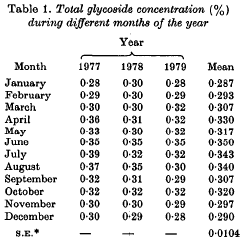Article contents
Seasonal influence on the total glycoside content of foxglove (Digitalis lanata)
Published online by Cambridge University Press: 27 March 2009
Extract
Several plants are cultivated for medicinal and aromatic purposes. Foxglove (Digitalis lanata) has been introduced into India from Western Europe and is cultivated for medicinal use. The leaves of D. lanata contain various glycosides, namely digoxin, gitoxin and gitalin, which are of medicinal value. This crop is cultivated throughout the year but not much information is available about

seasonal influence on the glycoside content. Hence, attempts are made to assess the effect of seasonal variation on total glycoside content and to arrive at an optimum season for harvesting the crop.
- Type
- Short Note
- Information
- Copyright
- Copyright © Cambridge University Press 1981
References
REFERENCES
- 1
- Cited by


